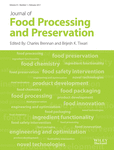Changes in Microbial Populations of WPC34 and WPC80 Whey Protein During Long-Term Storage†
Mention of trade names or commercial products in this article is solely for the purpose of providing specific information and does not imply recommendation or endorsement by the U.S. Department of Agriculture. “USDA is an equal opportunity provider and employer.”
Abstract
The effect of ambient relative humidity (70 and 90%, RH) and temperature and a 70 and 90% RH and temperatures (25, 30 and 35C) on microbial spoilage of whey protein concentrate (WPC34) and whey protein concentrate (WPC80) stored for up to 18 months were investigated. WPC34 and 80 were packaged in bags marked as standard (Std) and high performance (HP), and every 3 months changes in the behavior of aerobic mesophilic bacteria, yeast and mold and lipolytic bacteria were monitored. Initial populations of aerobic mesophilic bacteria in WPC80 and WPC34 averaged 2.7 and 1.6 log CFU/g, respectively. Yeast and mold populations of WPC34 in HP bags increased slightly during storage at 30 and 35C in a 70 and 90% RH, respectively, while lipolytic associated bacteria were not determined in the same samples. The pH of samples in all bags declined while water activity (aw) slightly increased during storage especially at higher RH and temperatures.
Pratical Applications
Information on the effect of adverse long-term storage conditions on whey protein concentrate (WPC) is needed for effective supply of this product to Africa and other semi-arid regions. This study investigated differences between ambient relative humidity storage, temperatures and type of bags on native microbial population, water activity and pH of WPC. It also, provides WPC manufacturers a better insight with regards to storage conditions and type of bags that can maintain longer shelf life. The data from this study could be used for quality control purposes and or development of a better bag suited for storage above ambient conditions.




